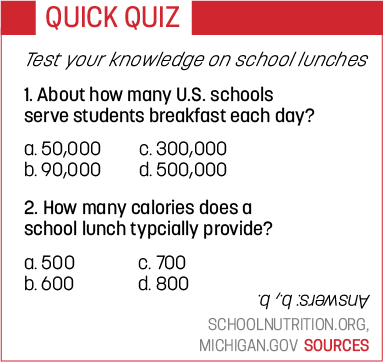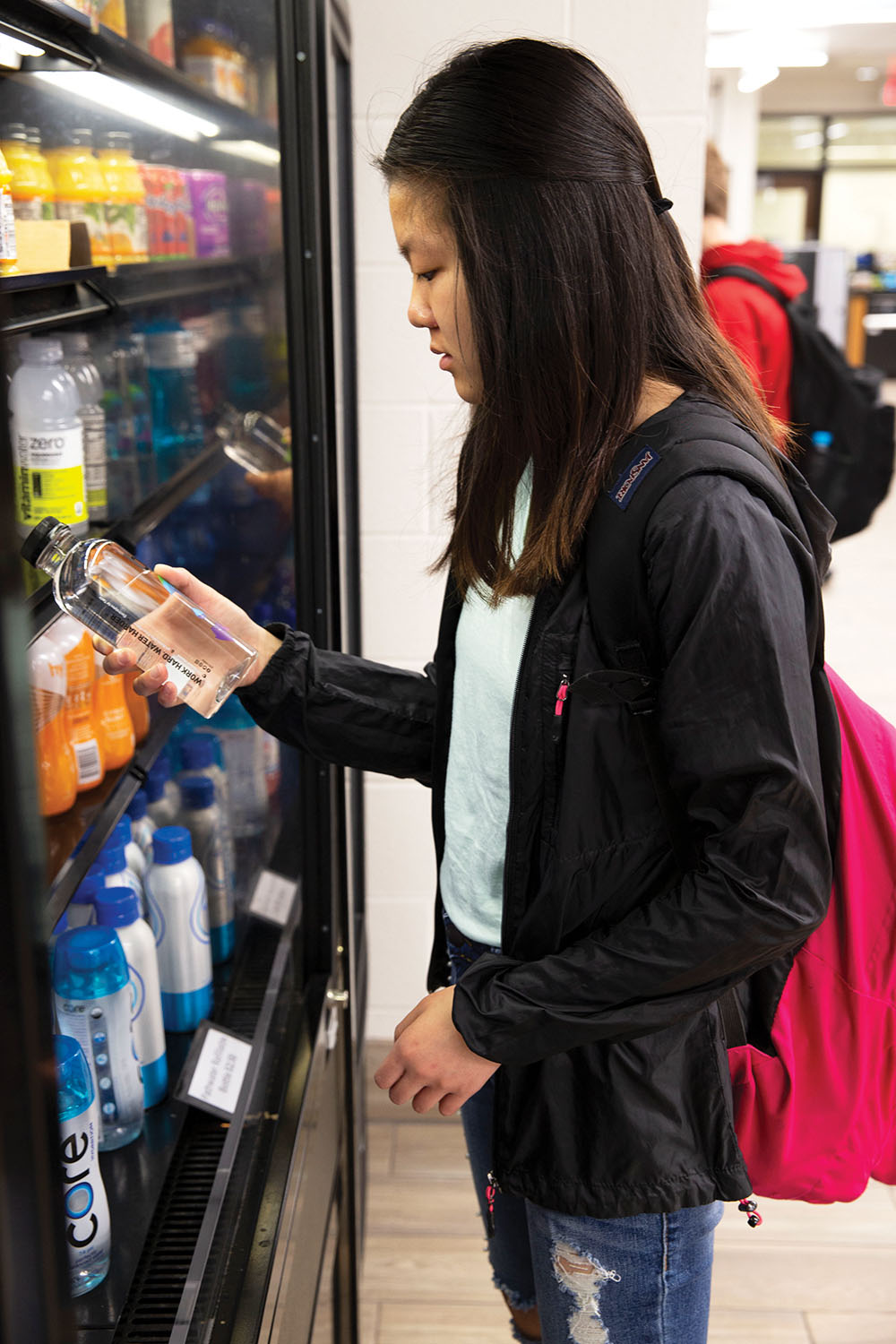While lunch is a part of day to relax and eat with friends, it is also a time to supply students’ bodies with the right nutrition. But what can and can’t be served has been the subject of controversy recently. In December, the Trump administration attempted to roll back the Obama-era Healthy and Hunger-Free Kids Act of 2010.
According to NPR, that rollback gave school lunch administrators flexibility in serving refined grains, including white breads, biscuits and white pastas. Last month, a coalition of states and advocacy organizations sued the Trump administration for that rollback.
Caught in the middle of these debates are cafeteria workers and the students themselves. Sophomore MeganLee, who both eats cafeteria lunches and occasionally brings her own lunch, said she sees merit to healthier foods.
“For some people, it’s a reality that they may not be getting healthy foods, so school is an opportunity where they’re guaranteed that they’ll be able to eat these healthy lunches,” she said.
However, while discussions continue nationally regarding lunch servings, CHS has continued to serve lunches according to its own regulations. Food service manager Holly Huepenbecker-Hull said she and her staff work hard to provide the best options for students.
“We work with a dietician,” she said. “The district has a dietician that helps plan the menus for our schools, so we have some input, and we will let her know things that are doing really well.”
 At CHS, there are certain regulations that the cafeterias follow. For example, according to Huepenbecker-Hull said, the cafeteria has specific guidelines where they can only offer certain vegetables or other items a certain number of times per week.
At CHS, there are certain regulations that the cafeterias follow. For example, according to Huepenbecker-Hull said, the cafeteria has specific guidelines where they can only offer certain vegetables or other items a certain number of times per week.
“Say a rice bowl that we are having today is a pretty popular (item),” she said. “We do have a certain serving size that we have to use, a certain type of rice that we have to use to meet those components. That’s a menu item that we know kids really like so we tell her to ‘keep that on there, it’s doing really well.’”
Lee said she has noticed the regulations and said, “I think there definitely are healthy foods in the form of fruits and vegetables, and the fact that to make a full meal you’re encouraged to get like a fruit and a vegetable and milk.”
Junior Adam Meroueh said he also has noticed the restrictions.
“I see regulations being put into place for lunches at CHS, and I think the school has more of a say in deciding what foods students are eating,” he said.
Ultimately, Lee said the school should be responsible for the health of lunches.
Lee said, “The school is the one who is providing (lunch), so if you have all these options in front of students and you encourage them in subtle ways to go for the healthier option instead of a bag of chips everyday, then that’s definitely going to encourage people to eat healthy. It does depend on the student to choose these options, but I do think that the school has some sort of responsibility to provide these options.”
While both Lee and Meroueh said the school currently has the most control over the health of lunches, they said students should have more control.
Meroueh said, “Students should still have a say in what they’re eating.”
 On days when Lee wants to eat more healthy, she said she often chooses to bring her own lunch.
On days when Lee wants to eat more healthy, she said she often chooses to bring her own lunch.
She said, “Being honest, (during the) times that I try to stay healthy, I pack my own lunch, so that way I can figure out what fruits and vegetables I want to eat and I can make my own sandwich or something that has healthier options other than the school food.”
Huepenbecker-Hull, however, said the school lunch is just as healthy as student-packed lunches.
“I would say most of the health of school lunches is based off of what kids get,” she said. “In general what we offer is fairly healthy. If kids will take an entree and all the components in it including the two veggies, two fruits and a milk, that is a healthy lunch.”
“If they have the money to buy the more unhealthy foods, we can’t tell them, ‘Oh it’s not healthy you can’t buy that,’” she added. “So especially at this age we rely on kids to regulate that and to balance themselves and to know what’s excessive and what’s reasonable.”

Sophomore Megan Lee looks at drinks in the cafeteria. She said she actively tries to find healthier options when eating school lunch.

































![What happened to theater etiquette? [opinion]](https://hilite.org/wp-content/uploads/2025/04/Entertainment-Perspective-Cover-1200x471.jpg)













































![Review: “The Immortal Soul Salvage Yard:” A criminally underrated poetry collection [MUSE]](https://hilite.org/wp-content/uploads/2025/03/71cju6TvqmL._AC_UF10001000_QL80_.jpg)
![Review: "Dog Man" is Unapologetically Chaotic [MUSE]](https://hilite.org/wp-content/uploads/2025/03/dogman-1200x700.jpg)
![Review: "Ne Zha 2": The WeChat family reunion I didn’t know I needed [MUSE]](https://hilite.org/wp-content/uploads/2025/03/unnamed-4.png)
![Review in Print: Maripaz Villar brings a delightfully unique style to the world of WEBTOON [MUSE]](https://hilite.org/wp-content/uploads/2023/12/maripazcover-1200x960.jpg)
![Review: “The Sword of Kaigen” is a masterpiece [MUSE]](https://hilite.org/wp-content/uploads/2023/11/Screenshot-2023-11-26-201051.png)
![Review: Gateron Oil Kings, great linear switches, okay price [MUSE]](https://hilite.org/wp-content/uploads/2023/11/Screenshot-2023-11-26-200553.png)
![Review: “A Haunting in Venice” is a significant improvement from other Agatha Christie adaptations [MUSE]](https://hilite.org/wp-content/uploads/2023/11/e7ee2938a6d422669771bce6d8088521.jpg)
![Review: A Thanksgiving story from elementary school, still just as interesting [MUSE]](https://hilite.org/wp-content/uploads/2023/11/Screenshot-2023-11-26-195514-987x1200.png)
![Review: "When I Fly Towards You", cute, uplifting youth drama [MUSE]](https://hilite.org/wp-content/uploads/2023/09/When-I-Fly-Towards-You-Chinese-drama.png)
![Postcards from Muse: Hawaii Travel Diary [MUSE]](https://hilite.org/wp-content/uploads/2023/09/My-project-1-1200x1200.jpg)
![Review: "Ladybug & Cat Noir: The Movie," departure from original show [MUSE]](https://hilite.org/wp-content/uploads/2023/09/Ladybug__Cat_Noir_-_The_Movie_poster.jpg)
![Review in Print: "Hidden Love" is the cute, uplifting drama everyone needs [MUSE]](https://hilite.org/wp-content/uploads/2023/09/hiddenlovecover-e1693597208225-1030x1200.png)
![Review in Print: "Heartstopper" is the heartwarming queer romance we all need [MUSE]](https://hilite.org/wp-content/uploads/2023/08/museheartstoppercover-1200x654.png)



